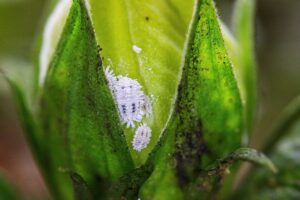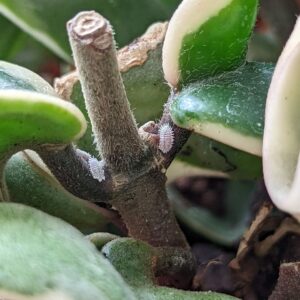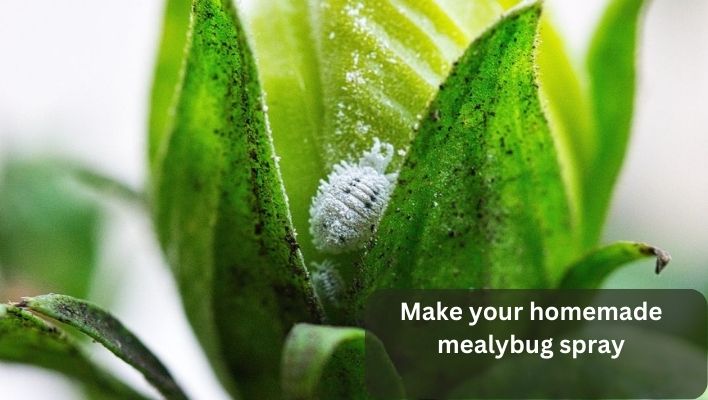Mealybugs are a common pest that can wreak havoc on your plants. These tiny insects feed on the sap of your plants and can cause damage to the leaves and stems. If left unchecked, mealybugs can weaken and even kill your plants.
They are pesky pests that can infest and damage plants, causing wilting and yellowing of leaves. While many commercial products are available to control mealybugs, many of these products contain harsh chemicals that can harm humans and the environment.
However, it is possible to make a natural, effective spray at home using common household ingredients. Homemade mealybug spray can be a safe and effective way to get rid of these pesky pests and protect your plants. While it may take a bit of time and effort, keeping your garden healthy and thriving is well worth it.
This post will explore making a natural, effective mealybug spray using ingredients you may already have at home. This homemade spray is safer for you and your plants and more budget-friendly than commercial pesticides. Read on to learn how to make mealybug spray and keep your plants healthy and pest-free.
What causes mealybugs
A lack of proper pest management and sanitation in gardens or greenhouse environments typically causes mealybugs. They can also be introduced to an environment by infested plants or plant material.
Mealybugs are attracted to stressed or damaged plants and can quickly reproduce and spread to other plants. These insects can also be transported to new plants on clothing, tools, or other objects, and they can also be carried by wind or birds. Below are some of the factors that can attract mealybugs to your plants
- Overwatering or poor drainage: Mealybugs are attracted to moist environments, so plants that are overwatered or have poor drainage may be more prone to infestations.
- High humidity: Mealybugs thrive in humid environments, so plants grown in greenhouses or other humid conditions may be more likely to attract mealybugs.
- Crowded conditions: Mealybugs thrive in crowded conditions where many plants grow close together. This makes it easier for them to spread from one plant to another.
- Bringing infested plants indoors: If you bring a plant indoors that is already infested with mealybugs, it can spread the insects to other plants in your home.
- Introduction of adult mealybugs: Mealybugs can also be introduced to a garden or indoor plant collection by adult insects that fly or crawl in from the outside.
- Lack of natural predators: In some cases, mealybugs may be able to thrive on a plant if there are no natural predators (such as ladybugs or lacewings) present to control their population.

Importance of controlling mealybug infestations
Mealybugs are small, sap-sucking insects that can cause significant damage to plants, leading to reduced growth and yield. They can also spread plant diseases, harming the affected plants’ health.
Controlling mealybug infestations is, therefore, essential for the health and productivity of crops and ornamental plants. If left unchecked, mealybugs can quickly spread from one plant to another and become a significant pest problem in a garden or farm.
Effective control measures include using a homemade spray, applying chemical pesticides, and regularly inspecting plants for signs of infestation. It is also important to promptly remove and dispose of any infected plants to prevent the spread of the pests to healthy plants.
By taking proactive measures to control mealybug infestations, gardeners and farmers can protect their plants and ensure a healthy, productive crop.
Homemade mealybug spray
Homemade mealybug spray is a natural and eco-friendly solution for getting rid of mealybugs on your plants. While many commercial options are available, these often contain harsh chemicals that can harm the environment and your plants.
You can make a mealybug spray at home using natural ingredients to kill pests and protect your plants effectively. Below are the various effective homemade mealybugs spray to make your garden pest free.
Dish soap
Dish soap is a good natural alternative to insecticides for keeping mealybugs at bay. It will keep them from reproducing and from infesting more plants.
Dish soap contains surfactants that help wash away the mealybugs’ protective wax coating. This makes washing your plant much easier. It’s super easy to make and a great way to keep those pesky little bugs from ruining your plants.
Ingredients:
- Two tablespoons of dish soap (preferably a natural, plant-based soap)
- 2 cups water
- 1 tablespoon baking soda
Instructions:
- Mix the dish soap, water, and baking soda in a spray bottle until well combined.
- Shake the bottle well before use.
- Spray the mealybugs directly, making sure to cover the entire plant and all affected areas.
- Repeat the spray every 2-3 days until the mealybugs are completely gone.
- Be sure to clean up any fallen mealybugs or egg masses to prevent re-infestation.
Note: This spray is safe for most plants, but it is always best to test a small, inconspicuous area before applying it to the entire plant to ensure it doesn’t cause any harm or damage.
Rubbing alcohol
You can use rubbing alcohol to wash off the mealybugs themselves, but you’ll also want to use it to sanitize the area around the plants after you’re done.
Ingredients:
- 1/2 cup rubbing alcohol
- 1 cup water
- 1 tsp dish soap
Instructions:
- Mix all ingredients in a spray bottle.
- Shake well to mix the ingredients.
- Spray the mixture directly on the mealybugs and coat them completely.
- Repeat the process every 3-4 days until the mealybugs are gone.
- Keep an eye on the plant to make sure no new mealybugs appear.
Note: This spray is safe for most plants, but it is always a good idea to test a small area of the plant first to ensure it does not cause any damage. Do not use this spray on plants that are sensitive to alcohol or soap. Additionally, be sure to wear protective gloves and avoid getting the spray in your eyes or on your skin. So, use caution while using this spray.
Neem oil
Neem oil is one of the best natural remedies for mealybugs. The oil is made from the flowers and seeds of the neem tree, which grows in many parts of India.
Neem oil works by killing the mealybug eggs, larvae, and adults. It also has antifungal properties that can help control other plant diseases, such as mildew and black spot, which are caused by fungi. To make a homemade mealybug spray using neem oil, follow these steps:
Ingredients:
- 1 cup water
- 1 teaspoon neem oil
- 1/2 teaspoon mild dish soap
Instructions:
- Combine the water, neem oil, and dish soap in a spray bottle.
- Shake the bottle well to mix the ingredients.
- Spray the solution directly onto the mealybugs and the plants they are infesting.
- Repeat the treatment every 7-10 days until the mealybugs are no longer present.
- To prevent future infestations, regularly inspect your plants and remove any visible mealybugs by hand.
Note: It is important to test the neem oil spray on a small, inconspicuous area of the plant before applying it to the entire plant. Some plants may be sensitive to neem oil and potentially suffer from leaf burn or other negative reactions.
Garlic
The garlic aroma gives the spray a unique scent, and it repels insects by masking their natural smell, making them unable to detect the smell of humans and other animals.
Homemade mealybug spray is effective against slugs, aphids, mealybug infestations, and leafroll beetles. This garlic mealybug spray is super easy to make, and it’s the perfect way to get rid of those annoying little pests that ruin your plants.
Ingredients:
- 1 clove of garlic
- 1 teaspoon of liquid soap (such as dish soap or insecticidal soap)
- 1 quart of water
Instructions:
- Peel and finely chop the garlic clove.
- Combine the chopped garlic, liquid soap, and water in a blender or food processor.
- Blend or process the mixture until the garlic is fully broken down and mixed with soap and water.
- Pour the mixture into a spray bottle.
- Spray the mixture directly onto the mealybugs and their nests.
- Repeat the spray every few days until the mealybugs are gone.
Note: This spray is safe for most plants, but it is always a good idea to test a small, inconspicuous area before applying it to the entire plant.

Chili peppers or cayenne pepper
Chili peppers or cayenne pepper homemade mealybug spray is a great way to control mealybugs in your houseplants. You can make this at home and have it ready to spray as soon as you see a problem. It’s simple, and it is cheap!
You will need the following:
- 1 cup of chili peppers (or cayenne peppers)
- 1 cup of water
- 1/4 teaspoon of dish soap
- A spray bottle
Instructions:
- Bring the water to a boil in a pot on the stove.
- Add the chili pepper flakes (or minced fresh chili peppers) to the pot and stir.
- Remove the pot from the heat and let it cool for about 15 minutes.
- Stir in the liquid dish soap.
- Pour the mixture into a spray bottle.
- Spray the mixture onto the plants infested with mealybugs, and coat the undersides of the leaves where the insects tend to hide.
- Repeat the treatment every few days until the mealybugs are under control.
Note: This spray may also harm beneficial insects, so it’s important to use it sparingly and only on plants that are heavily infested with mealybugs.
Vinegar
Vinegar is a fantastic solution for getting rid of mealybug infestations. It’s cheap, easy to make, and can be used in various ways.. To make a homemade mealybug spray using vinegar, you will need the following:
- 1 cup water
- 1 cup white vinegar
- 1 tablespoon dish soap
Instructions:
Mix the ingredients in a spray bottle and shake well to combine. Then, spray the mixture directly onto the mealybugs and the affected plants.
The vinegar and soap will work together to kill the mealybugs and help to control the infestation. Be sure to spray the undersides of the leaves as well, as this is where mealybugs often hide. Repeat the treatment every few days until the mealybugs are gone.
It’s important to note that this homemade vinegar spray is unsuitable for all plants. Some plants, such as ferns and succulents, may be sensitive to vinegar and could be damaged by the treatment. It’s always a good idea to test the spray on a small, inconspicuous area of the plant first to make sure it won’t cause any harm.
Diatomaceous Earth
Diatomaceous earth is an organic compound used for thousands of years as a natural pesticide. It’s made from fossilized fossils and has a very high surface area to volume ratio, which means it can absorb moisture from the air and hold onto it well. Here is everything you need to know about diatomaceous Earth (DE).
It is often used in gardening as a natural pest control method. To make a homemade mealybug spray using diatomaceous earth, you will need the following ingredients:
- 1 cup water
- 1 tablespoon diatomaceous earth
- 1 tablespoon liquid dish soap
Instructions:
To make the spray, combine the water and diatomaceous earth in a small spray bottle and shake well to dissolve the diatomaceous earth. Then, add the liquid dish soap and shake again to mix everything.
To use the spray, shake the bottle well and then apply the mixture to the affected plants, being sure to coat the undersides of the leaves where mealybugs often hide.
The diatomaceous earth will help to control the mealybugs by drying out their exoskeletons, while the dish soap will help to break down their protective wax coating and make them more vulnerable to the diatomaceous earth.
Hydrogen Peroxide
Hydrogen peroxide is a common household product that many people use to clean their homes and garden. It’s also an effective treatment for mealy bugs and other pests.
To make a homemade mealybug spray using hydrogen peroxide, you will need the following ingredients:
- 1 quart of water
- 1 tablespoon of hydrogen peroxide (3% concentration)
- 1 teaspoon of dish soap or castile soap
Mix these ingredients in a spray bottle and shake well to combine. Spray the solution on the affected plants, and coat the leaves’ undersides where mealybugs like to hide. Repeat the treatment every few days until the mealybugs are gone.
It’s important to note that hydrogen peroxide can harm plants if used in large amounts or applied too frequently. It’s a good idea to test the spray on a small, inconspicuous part of the plant before treating it. This will help you ensure that the solution is not causing any adverse effects.
Conclusion
In conclusion, homemade mealybug spray can effectively and economically control mealybug infestations in your garden or houseplants.
While it may take a bit of time and effort to gather the necessary ingredients and prepare the spray, the natural and safe nature of the solution makes it a desirable option for many gardeners and plant enthusiasts.
However, it is important to remember that homemade mealybug spray may not be as powerful as commercial pesticides and may require multiple applications to achieve the desired results.
Regardless, homemade mealybug spray can be a valuable tool in the fight against these pesky pests and is worth considering as a potential solution for your gardening needs.
